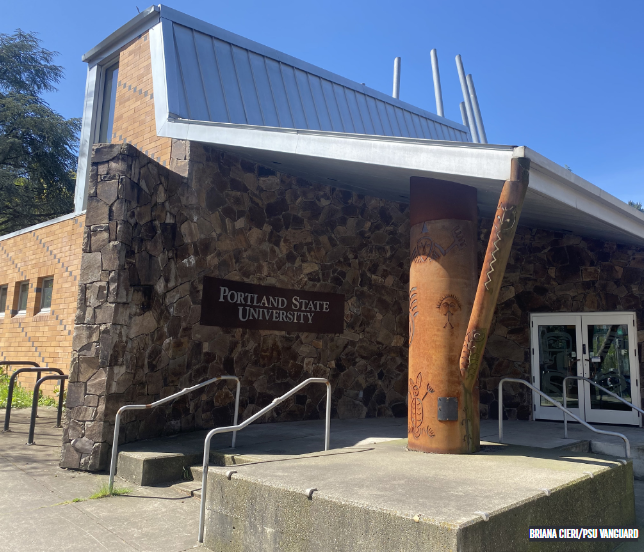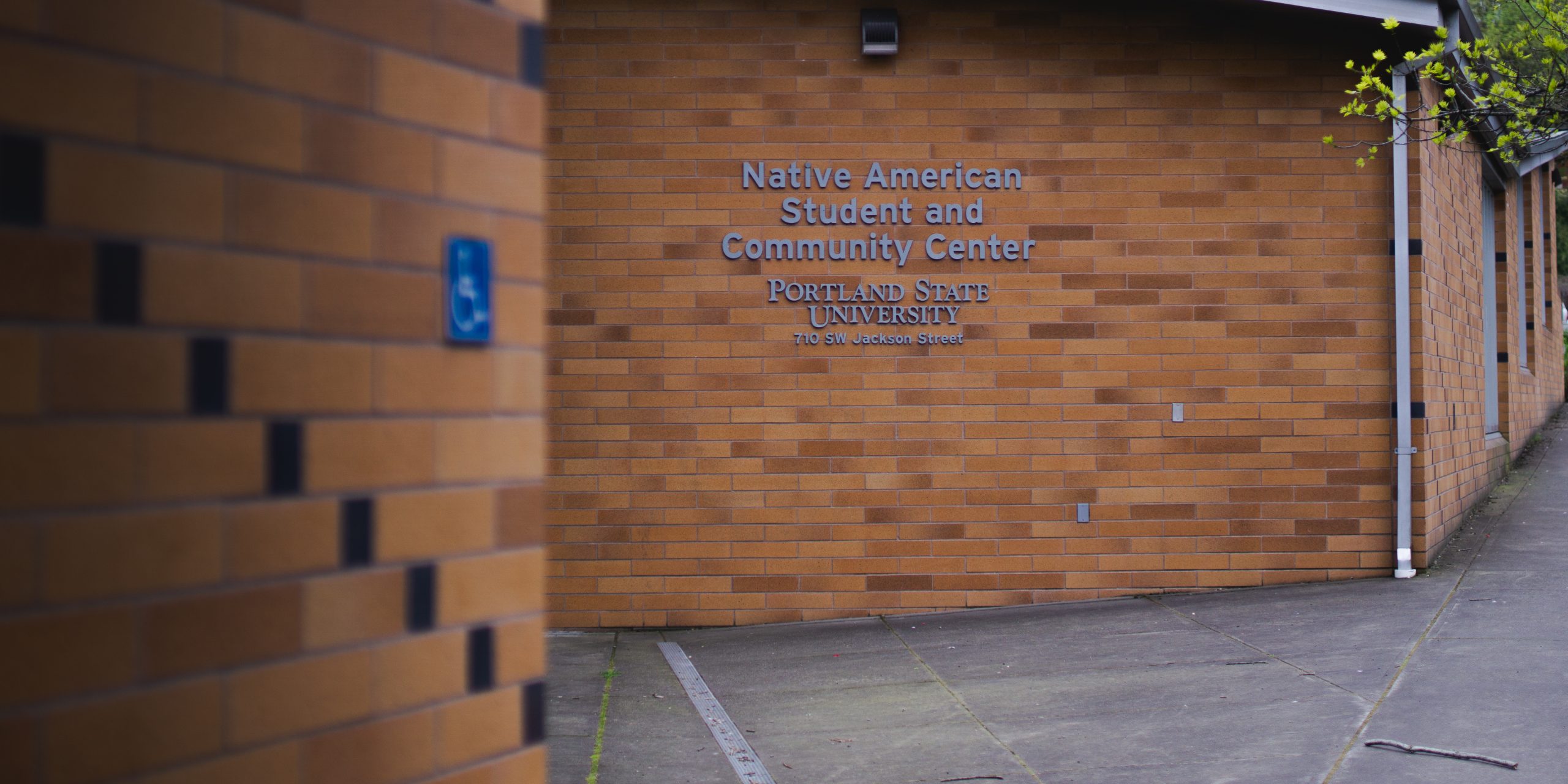Several students sat around a table in the Native American Student and Community Center during the middle of the Winter term. Their agenda was fairly straightforward, to discuss their concerns and fears over the facility’s handling in recent times.
“I felt catfished because I’m a transfer student. I come from out of state, and I saw on the NASCC website this beautiful building…” a student said, who wished to remain confidential. “So much programming, so many resources, so many clubs. Some of those don’t even exist anymore.”
“The NASCC used to be open until, like 2 or 3 a.m. They would be here all night… Now we can only enter during business operating hours,” a student said, who also wished to remain confidential. “We get locked out. We can’t be here. There’s no one to manage it. A lot of the time, it’s just completely empty.”
Like many of the students there, they were particularly concerned about a quiet reduction in the building’s operating hours that occurred this year, with multiple days cut out of its weekly schedule for over six months.
Professional staff at the NASCC claim the center was projected to earn approximately $40 thousand in revenue due to venue rentals last year, though departmental oversights led to only around $2,000 being collected. Staff and students report this led to staff reductions, long term vacancies of critical positions, reduced operating hours and heightened responsibilities for student-workers. Global Diversity and Inclusion (GDI), the NASCC’s supervising department, gave contrasting explanations.
Jay Molnar is the Program Coordinator for the NASCC. Molnar has worked in this position for three years, which is traditionally the most student-facing role in the center. Molnar recalled how the most recent issues at the center had begun to creep in at the beginning of the academic year. Molnar recollected a specific team meeting with GDI around the start of the Fall term.
“They called that at the beginning of the year, and just kind of told us, this is the situation…[the NASCC] is a revenue generating building…” Molnar said, elaborating on the role professional and student staff play in the building’s finances. “The center charges outside organizations to rent the building, and they do it for events and stuff like that.”
According to Molnar, the only responsibility they have is to send out invoices after events. Once the invoices are out, they have no authority to follow up.
“So all the invoices were sent out, and we know that they were sent out because they have documentation of how much money was made, which was $40,000 for the year,” Molnar said. “Apparently only $2,000 worth of that was paid.”
According to NASCC staff, the exact nature of how this error occurred is unknown.
Molnar spoke on the status of the center during the public comment section at the Board of Trustees’ January meeting.
“I know for a fact after I spoke to the Board of Trustees about this particular issue that they not only hadn’t heard about it, but they also didn’t know about any of the other struggles going on, like for the center or within GDI,” Molnar said.
A campus-wide email was sent out by Board of Trustees Chair Benjamin Berry on April 11, following up on the April Board of Trustees meeting, in which there was a Tribal Relations Update. In the email, Berry stated:
“Public comments also addressed concerns about reduced staffing at the Native American Student and Community Center (NASCC)… I have asked for a deeper review of these topics to better understand the issues that were shared, and while I can not provide an update at this time, I am looking into these concerns.”
Araceli Cruz is one of the current Associate Vice Presidents of GDI and has held the position since November of 2023. Cruz oversees Student Legal Services, the Veterans Resource Center and the NASCC.
In a previous interview with PSU Vanguard held prior to Molnar’s interview, Cruz addressed the long-term vacancy of the building manager position, a critical role in facilities management that had been empty since the previous manager resigned at the end of Spring last year.
In the interview, Cruz claimed the vacancy was intentional and the result of university-wide budget cuts.
“The position is vacant, but we are hiring an interim… because of the budget cuts, the NASCC was also impacted, just like across the institution,” Cruz said. “So we did have to leave the position vacant for six months to allow for some salary savings that we needed to meet… so it is taking a little bit longer to post.”
Molnar said they never received any explanation as to why the position remained vacant for so long but were instead told efforts were being made to fill the position throughout its vacancy. No other staff members or students interviewed said they’d heard this explanation, but a majority independently claimed they were under the impression the position was supposed to have been filled permanently by January. Molnar additionally claims that GDI told them in that same meeting that the building hours were being reduced in order to save utility costs, specifically electrical and HVAC.
“They should have been honest and been like, we can’t afford to pay enough student workers to keep it open every day of the week instead of ‘we need to shut off the electricity and HVAC,’” Molnar said.
Cruz did not mention the $38 thousand shortfall in her first interview with PSU Vanguard, which was held prior to Molnar’s interview in which the shortfall was first mentioned. Cruz agreed to respond to follow-up questions over email after the fact. When asked if the shortfall existed, Cruz did not directly confirm, but stated:
“A list of pending invoices is reviewed regularly throughout the year. During our March review of last year, we identified a significant number of outstanding invoices, including some that were more than 365 days old. In response, staff followed up with clients to ensure payments were submitted… We rely on our clients to submit their payments at their earliest convenience. As an organization, we do not send outstanding balances to collections, which can occasionally result in delayed payments. Currently, payments for external users are primarily accepted by check, which has presented some logistical challenges. A new campus-wide system is in development that will enable credit card payments, significantly improving the efficiency and timeliness of the payment process.”
When asked for clarification on her statements regarding “salary savings” and if they were the reasoning behind the changes, Cruz declined to comment, but provided a copy of a letter sent from GDI Vice President Ame Lambert addressing the recent concerns related to the NASCC.
“It is no secret that PSU has had to pull on a variety of levers to help close its budget deficit…” Lambert stated in the letter. “One of the levers to address the deficit now includes attributing a certain amount of salary savings to each unit… We only had two open positions on general funds this fiscal year: the NASCC manager and an Investigator position… So we made the difficult decision to hold them both open…”
One of the central concerns that students raised was the relocation of professional staff to Smith Memorial Student Union during most of the week. Molnar, for instance, previously worked at Smith just one day per week. Two days were spent remote, and two days were spent inside the NASCC. Now, Molnar only spends one day per week at the NASCC but is required to return to Smith after 5 p.m. on most of those days.
On the staff relocations, Cruz said:
“More of the student traffic is happening in Smith, so we adjusted the schedule so now every professional staff has just one day in the office… then they support students back in Smith, because that’s where they need to be… We wanted to support students in a more holistic way, and because the need is over there in Smith right now, we needed to ensure that we also had staff supporting students there.”
Students who frequent the center held different perspectives, citing relocation of indigenous staff as a culturally and contextually sensitive issue.
“Our resources are being relocated, which I feel is very insensitive to our students, who do have a very close connection with culture, and a sense of relocation is a very traumatizing thing to have to be reintroduced to,” said a student who wished to remain confidential. “So you’re putting students through traumatic experiences. Maybe you don’t realize it, but you are.”
Molnar echoed similar sentiments.
“The students are like, we don’t feel comfortable being there unless there’s a native authority figure there,” Molnar said.
This is not the first time staff relocations have occurred at the NASCC despite the community and staff’s disapproval. A source shared a letter of correspondence detailing an eerily similar situation that occurred in 2013. At the time, the University was struggling with a $15 million shortfall in revenue, a fact that led the University President at the time, Wim Wiewel, to propose tuition hikes and faculty terminations.
The letter was addressed to Wiewel and signed by Jackie Leno Grant, Chair of the Oregon Indian Coalition on Post-Secondary Education. It details how the university had re-organized the duties of the Student Services Coordinator position (Molnar’s current position), at the time held by Dean Azule. One of the complaints raised was that Azule was required to split his time between the NASCC and Smith.
“Historically, changes such as these; made without consultation with tribal education leaders, parents and students themselves, sends a message to tribal students and communities that their educational needs are not valued in the overall mission of the University,” the letter stated.
According to a former coworker of Azule during this time, who wished to remain confidential, the backlash prompted the University to reallocate his hours at the NASCC.
Trevor Roberts was the former building manager and the last person to hold the permanent position. He resigned from the position at the end of Spring 2024.
“I like to joke about how it always felt like I walked into a burning building and I was given like a super soaker,” Roberts said.
Roberts did not wish to go on the record with the specific details of his resignation, but he cited challenging working conditions and mental fatigue as principal factors.
“I just had to get out because my mental health was suffering,” Roberts said. “I was not sleeping. It was just a lot of stress and a lot of pressure, and I just had to kind of step away from that… I was sad to leave the role and being able to work with my community… [but] I do feel like it was the best decision I made at that time.”
Roberts similarly claimed mismanagement at the middle administrative level was a central source of his dissatisfaction.
“Speaking candidly, I guess I don’t believe that GDI hired the most qualified candidate for the Assistant Vice President position,” Roberts said. “There was a lot of learning time and a learning curve that just made my job a lot harder… there was not enough me, and there was not enough time in the day to handle all the building’s needs, like I had been for the past year and a half.”
Both Cruz and Molnar said that the facility was greatly supported by student-workers employed at the center during this time. However, their respective viewpoints on the conditions varied.
“I think it’s always challenging when you do have a vacancy because you do need someone to be there, and so I think that can sometimes be hard, but I know that we have a great group of work-study students who are also supporting us,” Cruz said.
Molnar held a contrasting perspective, claiming the working conditions were unfair for student-workers.
“The NASCC closes at five,” Molnar said. “However, the student groups usually have their meetings from five to seven over there, so someone has to be there. So since I’m not there, it ends up being like, the one student worker who doesn’t get paid over time is kind of forced to be there.”
Students similarly credited their own peers as being foundational to the center’s success, also noting they felt overwhelmed with responsibilities.
“I’m just very proud of all of the students that are here and the fight that we have had to continue—to make sure that there’s something for the next cohort to walk into,” a student said, who chose to remain confidential. “Maybe it’s something less and less, but we just want to make sure that there’s something here.”
On Thursday, Mar. 20, there was an incident in which a seemingly unhoused individual tried to gain access to the building through the lower level entrance. The individual appeared to be mentally unwell and was repeatedly banging on the doors and shouting requests to enter.
Cruz was in her office at the time but did not exit to address the situation. Ultimately, the individual was approached by a student inside the center. According to Molnar, the student was not an employee, nor had they received any conflict resolution or de-escalation training. Regardless, the student was able to de-escalate the situation, and the individual left peacefully.
PSU Vanguard was present at the time of this event and witnessed it unfold.
As of Apr. 3, an interim building manager was hired at the NASCC, and the building hours were reinstated to 9 a.m. – 5 p.m., Monday through Friday. No formal announcements were made.







